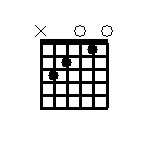Open note on:
[Wikipedia]
[Google]
[Amazon]
On
 ).
On plucked string instruments with
).
On plucked string instruments with
string instrument
String instruments, stringed instruments, or chordophones are musical instruments that produce sound from vibrating strings when a performer plays or sounds the strings in some manner.
Musicians play some string instruments by plucking the s ...
s, a stopped note is a note whose pitch has been altered from the pitch of the open string by the player's left hand pressing (stopping) the string against the fingerboard.
Bowed strings
On bowed string instruments, a stopped note is a played note that is fingered with the left hand, i.e. not an open string.Andrea Pejrolo, Rich DeRosa (2007). ''Acoustic and MIDI Orchestration for the Contemporary Composer'', p.99-100. . This assists with tone production, the addition ofvibrato
Vibrato ( Italian, from past participle of " vibrare", to vibrate) is a musical effect consisting of a regular, pulsating change of pitch. It is used to add expression to vocal and instrumental music. Vibrato is typically characterised in terms ...
, and sometimes additional volume
Volume is a measure of occupied three-dimensional space. It is often quantified numerically using SI derived units (such as the cubic metre and litre) or by various imperial or US customary units (such as the gallon, quart, cubic inch). ...
but creates difficulty in that bowed string instruments do not have fret
A fret is any of the thin strips of material, usually metal wire, inserted laterally at specific positions along the neck or fretboard of a stringed instrument. Frets usually extend across the full width of the neck. On some historical instru ...
s, requiring ear training
Ear training or aural skills is a music theory study in which musicians learn to identify pitches, intervals, melody, chords, rhythms, solfeges, and other basic elements of music, solely by hearing. The application of this skill is analogous t ...
and accurate finger placement. The lack of frets, as on the guitar fretboard, does allow greater variability in intonation though a bowed string instrumentalist, such as a violinist, "when unaccompanied, does not play consistently in either the tempered or the natural scale, but tends on the whole to conform with the Pythagorean scale"
The open notes of the highest three strings may be played as stopped notes on the lowest three strings, offering advantages and disadvantages:
Fingered tremolos, the rapid alternation of two notes, are best between two stopped notes on one string, in which case it is limited to the interval of an augmented fourth
Augment or augmentation may refer to:
Language
*Augment (Indo-European), a syllable added to the beginning of the word in certain Indo-European languages
*Augment (Bantu languages), a morpheme that is prefixed to the noun class prefix of nouns i ...
, or between stopped notes on two adjacent strings:Cecil Forsyth (1982). ''Orchestration'', p.356. .
Plucked strings
 ).
On plucked string instruments with
).
On plucked string instruments with fret
A fret is any of the thin strips of material, usually metal wire, inserted laterally at specific positions along the neck or fretboard of a stringed instrument. Frets usually extend across the full width of the neck. On some historical instru ...
s, such as the guitar, the pitch of a stopped note is determined by the left hand pressing (stopping) the string at one of the frets.
Sources
{{Musical technique String performance techniques